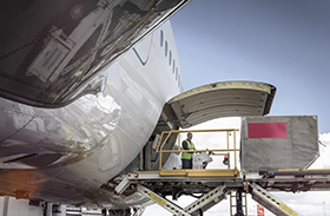
Translations
La demanda de carga aérea se estabiliza en julio.Continúa la limitación de la capacidad (pdf)
国际航协:7月份航空货运需求稳定 运力持续紧缩 (pdf)
Demande stable en juillet dans le secteur du fret aérien – la capacité demeure limitée (pdf)
Demanda de carga aérea estável em julho, mas capacidade permanece reprimida (pdf0
Geneva - The International Air Transport Association (IATA) released data for global air freight markets in July showing air cargo demand is stable but at lower levels than 2019. While there is some month-to-month improvement, it is at a slower pace than some of the traditional leading indicators would suggest. This is due to the capacity constraint from the loss of available belly cargo space as passenger aircraft remain parked.
- Global demand, measured in cargo tonne-kilometers (CTKs*), fell by 13.5% in July (-15.5% for international operations) compared to the previous year. That is a modest improvement from the 16.6% year-on-year drop recorded in June. Seasonally-adjusted demand grew by 2.6% month-on-month in July.
- Global capacity, measured in available cargo tonne-kilometers (ACTKs), shrank by 31.2% in July (‑32.9% for international operations) compared to the previous year. This is a small improvement from the 33.4% year-on-year drop in June.
- Belly capacity for international air cargo shrank by 70.5% in July compared to the previous year owing to the withdrawal of passenger services amid the COVID-19 pandemic. This was partially offset by a 28.8% increase in capacity through expanded use of freighter aircraft.
- Economic activity continued to recover in July reflected in the performance of the Purchasing Managers’ Index (PMI), an indicator of economic health in the manufacturing sector:
- The new export orders component of the manufacturing PMI rose by 3.5 points compared to June, and was up 19.8 points since April
- The PMI tracking global manufacturing output returned to above 50, consistent with month-on-month growth in output
“Economic indicators are improving, but we have not yet seen that fully reflected in growing air cargo shipments. That said, air cargo is much stronger than the passenger side of the business. And one of our biggest challenges remains accommodating demand with severely reduced capacity. If borders remain closed, travel curtailed and passenger fleets grounded, the ability of air cargo to keep the global economy moving will be challenged,” said Alexandre de Juniac, IATA's Director General and CEO.
July Regional Performance
Asia-Pacific airlines saw demand for international air cargo fall by 15.3% in July 2020 compared to the same period a year earlier. After a robust initial recovery in May, month-on-month growth seasonally-adjusted demand has softened. International capacity decreased 32.0%
North American carriers reported a single digit fall in international cargo demand of 5.4% year-on-year in July. The stronger performance is due in part to strong demand on the transpacific, Asia-North America route, reflecting e-commerce demand for products manufactured in Asia. International capacity decreased 30.9%.
European carriers reported a 22.4% annual drop in international cargo volumes in July. This was a slight improvement from June’s performance of -27.6%. Demand on most key trade lanes to / from the region remained weak. The large Europe–Asia market was down 20% year-on-year in July. International capacity decreased 37.4%.
Middle Eastern carriers reported a decline of 14.9% in year-on-year international cargo volumes in July, an improvement from the 19% fall in June. Seasonally-adjusted demand grew 7.2% month-on-month in July–the strongest of all regions. This recovery was driven by the aggressive operational strategies of some of the region’s carriers. International capacity decreased 27.1%, the most resilient of all regions.
Latin American carriers posted a 32.1% drop in year-on-year international demand in July, down from a 28.6% decline in June. International capacity decreased 44.5%. The drop in both demand and capacity was the most severe of all regions. The COVID-19 crisis is particularly challenging at present for airlines based in Latin America owing to strict lock-down measures. In July the Latin American air cargo market was smaller than the African market for the first time since these statistics have been reported in 1990.
African airlines posted a contraction of 3.0% in July. This was down from a 3.8% increase in demand in June. The small Africa-Asia market continued to support the region’s performance. International capacity decreased 33.7%.
View July Cargo Results (pdf)
For more information:
Corporate Communications
Tel: +41 22 770 2967
Email: corpcomms@iata.org
Notes for Editors:
- Please note that as of January 2020 onwards, we have clarified the terminology of the Industry and Regional series from ‘Freight’ to ‘Cargo’, the corresponding metrics being FTK (changed to ‘CTK’), AFTK (changed to ‘ACTK’), and FLF (changed to ‘CLF’), in order to reflect that the series have been consisting of Cargo (Freight plus Mail) rather than Freight only. The data series themselves have not been changed.
- IATA (International Air Transport Association) represents some 290 airlines comprising 82% of global air traffic.
- You can follow us at twitter.com/iata for announcements, policy positions, and other useful industry information.
- Explanation of measurement terms:
- CTK: cargo tonne-kilometers measures actual cargo traffic
- ACTK: available cargo tonne-kilometers measures available total cargo capacity
- CLF: cargo load factor is % of ACTKs used
- IATA statistics cover international and domestic scheduled air cargo for IATA member and non-member airlines.
- Total cargo traffic market shares by region of carriers in terms of CTK are: Asia-Pacific 34.5%, Europe 23.6%, North America 24.3%, Middle East 13.0%, Latin America 2.8%, and Africa 1.8%.

